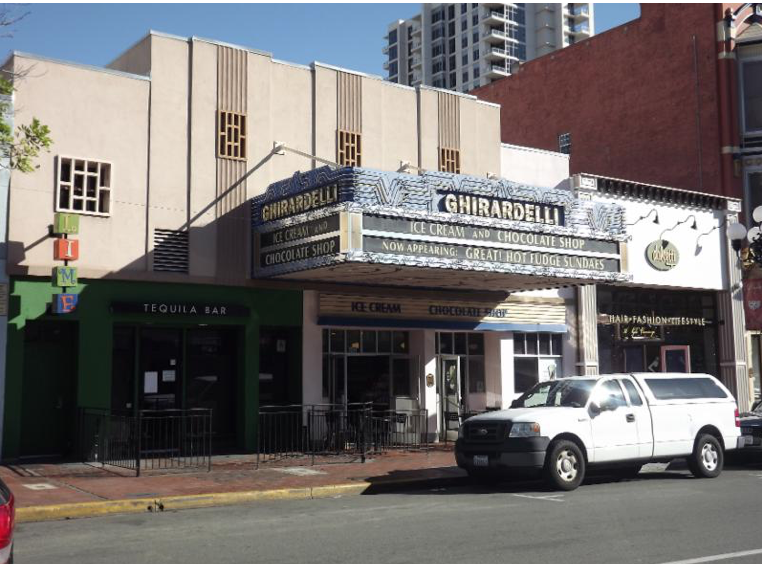Landmarks
From Silver Screen to Sundaes: Casino Theater
Prior to 1904 , the property between 643 and 651 Fifth Avenue was nothing more than a series of small wooden buildings housing a shoemaker, a jeweler and a cigar and cigarette merchant. In 1904, George J. Chambers , father of famed Olympic swimmer Florence Chambers, purchased the property from L.G. Pratt for the unlikely sum of $10. Mr. Chambers, who at the time ran a second-hand furniture store on Sixth Avenue, decided not to develop his property until 1912.
In March 1912, the San Diego Union reported that excavation had begun on the first fireproof theater building on the Chambers lot, on the east side of Fifth Ave. opposite City Hall. The structure , to be built by A. E. Chaffey, would be a one-story concrete building, seating 800 patrons, and would be the first to comply with the new building ordinance. It would have a passage on either side and in the rear as a means of protection in the event of fire. Two exits would be located at the stage end of the auditorium, opening to the outside passageway.
One year later, the building permit was granted for a one story, steel reinforced concrete theater. A projected cost was $6,000. Unfortunately, only two years after construction, the two side passages were converted into a restaurant and a shoe shine establishment. Although Chambers owned the land, the Casino Amusement Company owned the building. Hence, the building was named the Casino Theater. In 1931, the property was acquired by Vincent and Concetta Russo, who had run the theater since 1921. The Russo family operated the business through 1956.
Gaslamp pioneer Tom Hom reminisces in his book, Rabbit on a Bumpy Road, about the times he treated himself and a friend to a show at the Casino. In the 1930’s, it cost a dime for entry, which would ensure the patron 2-3 main features, a serial chapter of the “Lone Ranger” or other hero of the times, a comedy short featuring “The Three Stooges,” and a cartoon. The entire matinee lasted about four hours. So – for a complete afternoon’s entertainment, a quarter paid for two admissions , with a nickel left over for a hot dog to share! Not a bad deal!

The building continued to be run as a theater, although after the Russos, there were a series of proprietors. Additionally, as the area below G Street deteriorated , the clientele also changed, and X-rated movie houses became the norm.
In the 1970s, enter Mr. Tom Hom again, who along with his wife , Dorothy, began a widespread restoration of the Gaslamp area to its original splendor. As the restoration continued, it became quite obvious that old movie houses had outlived their purposes, and could not compete with the multi-plex theaters now opening. Developers began looking for other viable tenants. The building underwent an extensive restoration, during which the marquee had to be replaced with a slightly larger replica of the original.
The Casino re-opened as the very popular Ghirardelli Ice Cream Parlor and Chocolate Shop, which offers a tasty welcome and a complimentary piece of their famous chocolate to all who enter.
Sandee Wilhoit is the Historian for the Gaslamp Quarter Historical Foundation.
She can be reached at [email protected]

